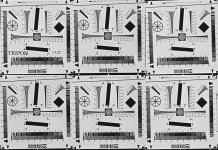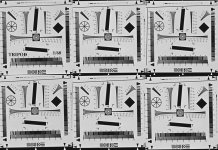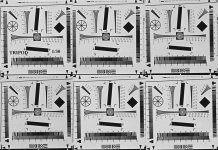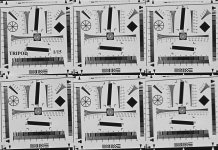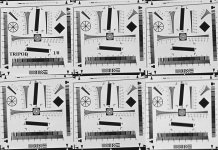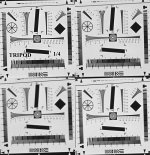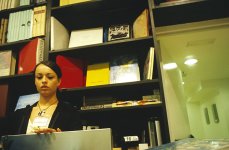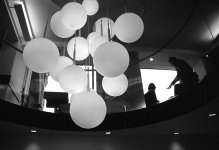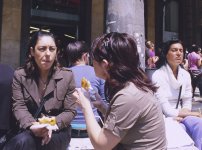mfogiel
Mentor
I am coming back on the question of the critical sharpness when handholding a rangefinder. The lure of being able to shoot in available light at lower speeds respect to a SLR has been one of the two main reasons to try a ranngefinder ( the other being the relative compactness). I have started my tests with a BESSA R4A and an Elmarit 28/2.8.
The shots have been done from a distance of about 1m on a 100 ISO transparency, and then converted to b&w for the sake of clarity. I have done some capture sharpening, though not excessively - at a usual level for a medium acutance subject. The results are displayed as a mosaic, with the upper left shot done on a tripod for reference. Unfortunatelly, I have wasted a couple of frames too many at the beginning of the roll, so the last test consists of just 4 shots, but I think it is sufficient anyway.
I am not claiming to be a particularly steady hand guy, but I have tried to concentrate on my task, and surely in real life field conditions it would be difficult to expect a better result (from me)... So take the results with a pinch of salt, as your hand could be more steady...
The single crops are 910x941 pixels, and correspond to a scan @4000ppi. If you print such a scan at 240dpi, you get a 15x22,6 inch print (38x57cm), pretty much an A2 size, and bigger than most of us would be prepared to print from a 35mm negative.
I have actually printed these pages, so my comments will refer to what I can see on paper.
Finally, let's hope I will manage to post all this without making a mess...
The first image relates to the speed of 1/125 (f2.8), and I can see that all the frames are critically sharp, maybe with the exception of the third, but I am convinced this is related to a slight misfocussing, and not image blur.
The shots have been done from a distance of about 1m on a 100 ISO transparency, and then converted to b&w for the sake of clarity. I have done some capture sharpening, though not excessively - at a usual level for a medium acutance subject. The results are displayed as a mosaic, with the upper left shot done on a tripod for reference. Unfortunatelly, I have wasted a couple of frames too many at the beginning of the roll, so the last test consists of just 4 shots, but I think it is sufficient anyway.
I am not claiming to be a particularly steady hand guy, but I have tried to concentrate on my task, and surely in real life field conditions it would be difficult to expect a better result (from me)... So take the results with a pinch of salt, as your hand could be more steady...
The single crops are 910x941 pixels, and correspond to a scan @4000ppi. If you print such a scan at 240dpi, you get a 15x22,6 inch print (38x57cm), pretty much an A2 size, and bigger than most of us would be prepared to print from a 35mm negative.
I have actually printed these pages, so my comments will refer to what I can see on paper.
Finally, let's hope I will manage to post all this without making a mess...
The first image relates to the speed of 1/125 (f2.8), and I can see that all the frames are critically sharp, maybe with the exception of the third, but I am convinced this is related to a slight misfocussing, and not image blur.
Attachments
mfogiel
Mentor
In the case of the test at 1/60, there can be an impression that there is a tiny bit of softening in the images nr 3 and nr 5, but it is only visible at a very close distance, and again I am not really sure if it relates to camera shake or slight misfocussing. All in all I would say the 1/60th test is a pass for critical sharpness.
Attachments
mfogiel
Mentor
mfogiel
Mentor
At 1/15 we are entering the slippery ground. The shots nr2 and especially nr6 are blurred, but the good news is, that the other 3 are still as good as the tripod one, so this is the kind of speed where a personal ability starts to weigh. I would call this the 50/50 zone.
Attachments
mfogiel
Mentor
At 1/8 we are in the moving sands territory. In fact not a single handheld shot is critically sharp, although nr3 comes very close. Nr 2,4 and 5 would be acceprtable for an 8x10 print without any problem, or for an 11X14 portrait without demanding detail, but nr6 is simply blurry.
Attachments
mfogiel
Mentor
Finally, we have the 1/4 series, and frankly this is stuff that could be acceptable only if you were shooting at Omaha Beach on the D day, but not for critical appraisal of fine detail. None of the handheld shots is really sharp, but considering that even the tripod one looks less defined due to diffractiion (it has been taken at f22), nr2 could possibly be useful for a 6x8 enlargement.
Attachments
Last edited:
mfogiel
Mentor
To wrap up - what I see, is that with a bit of a steady hand you can expect to get first rate results down to 1/2 of your focal length (28/2=14, so 1/15), and if you concentrate and take several shots, maybe even down to 1/4 of your focal length.
However, in normal conditions, when you might just have the time for a single shot without too much of a preparation, it is still safer to stick to the old rule of using the focal length as a proxy for the slowest speed.
I do not know, how much the particular camera or lens have influenced the results of this test, and when I get some time during this summer, I intend to repeat this type of test with other cameras that I use handheld - this will include a Nikon FM3A, a Fuji S3 Pro, and several Hasselblad models.
I hope you will consider this stuff interesting, and obviously if anybody else feels like doing tests on other kind of gear, we might actually cover even more stuff...
However, in normal conditions, when you might just have the time for a single shot without too much of a preparation, it is still safer to stick to the old rule of using the focal length as a proxy for the slowest speed.
I do not know, how much the particular camera or lens have influenced the results of this test, and when I get some time during this summer, I intend to repeat this type of test with other cameras that I use handheld - this will include a Nikon FM3A, a Fuji S3 Pro, and several Hasselblad models.
I hope you will consider this stuff interesting, and obviously if anybody else feels like doing tests on other kind of gear, we might actually cover even more stuff...
ferider
Mentor
Nicely done. Thanks !
Roland.
Roland.
Bryce
Well-known
A good idea for a test, and actually very instructive for the intended purpose of these cameras for many of us.
Real world 'testing' like this made me give up on available light shooting in really dark conditions, with the enormous failure rate that came with it. Even if you can stand perfectly still, your subjects usually won't. Also there is the very narrow latitude of pushed films.
I've gained a lot of respect for people who consistently shoot good nightlife images without flash from these experiences.
Real world 'testing' like this made me give up on available light shooting in really dark conditions, with the enormous failure rate that came with it. Even if you can stand perfectly still, your subjects usually won't. Also there is the very narrow latitude of pushed films.
I've gained a lot of respect for people who consistently shoot good nightlife images without flash from these experiences.
Bryce
Well-known
By all means, keep up the testing if you feel you'd like to. It would be very interesting to see how other camera designs stand up to low speed, handheld shooting.
That said, I have noticed this- I have a Mamiya TLR and a short neckstrap, and holding the camera firmly against my chest and holding my breath I have made critically sharp negatives a few times at 1/15 second. Of course the subjects were inanimate objects, but I think it worked because a human torso is much easier to keep stationary than one's hands and face.
So I'd be very interested to see how the Hasselblad works out. If shot while being held the same way as the TLR, it might have a chance, but then there is that mirror bounce thing...
That said, I have noticed this- I have a Mamiya TLR and a short neckstrap, and holding the camera firmly against my chest and holding my breath I have made critically sharp negatives a few times at 1/15 second. Of course the subjects were inanimate objects, but I think it worked because a human torso is much easier to keep stationary than one's hands and face.
So I'd be very interested to see how the Hasselblad works out. If shot while being held the same way as the TLR, it might have a chance, but then there is that mirror bounce thing...
R
rich815
Guest
Real world, on the fly, being quick before that street scene changes....is a completely different story than shooting targets at leisure and in a controlled situation. IMO, for critical sharpness, and I mean for CRITICALLY sharp negs, I never shoot below 1/250th. Sure, 1/125th, 1/60th or even 1/30th may come out acceptably sharp and I often use those speeds. Even down to 1/15th if I'm just shooting something architectually with my RF, but when I scan negs on my Nikon LS-4000 and really look at the scan at 100% I'm often surprised at how often many street and documentary images have a soft edge when shot under 1/250th.
aizan
Mentor
i think i remember that winogrand typically shot at 1/1000 outdoors. might try that. 
Anupam
Well-known
The interesting twist would be to shoot the same lens on an SLR and compare. For street shooting I am trying out really slow film - EI 50 - and exploring daytime exposures between 1/4 and 1/15 to blur motion. The RF allows me to have the immobile background reasonably sharp.
-A
-A
R
RML
Guest
Nice results, that confirm what's been told many times over.
However, like said before too, if you want critically sharp shots while "on the run", you'd better stick with 1/250 or faster.
And then, when critically sharp doesn't matter or is at least of minor importance (HCB's shots are often anything but critically sharp, for instance), you can get away with 1/15 and slower.
However, like said before too, if you want critically sharp shots while "on the run", you'd better stick with 1/250 or faster.
And then, when critically sharp doesn't matter or is at least of minor importance (HCB's shots are often anything but critically sharp, for instance), you can get away with 1/15 and slower.
ClaremontPhoto
Jon Claremont
Some brick wall in your den, or newspaper?
oscroft
Mentor
That's very interesting - many thanks for doing it
Nicely done. I am not one much for "static" tests in general. But this was to the point and easy to relate to. The point is well made about bumping up the speed when shooting on the run, but it is nice to see what works in this manner in a controlled situation.
mfogiel
Mentor
I have tried to post these in a new thread, but the server doesn't seem to work.
This is a triple primer: new camera (Bessa R4A), new lens (Elmarit 28) and new film (Provia 400x) just arrived from Japan.
The shots are not perfect, but I think this is a good example of "marginal" shots, that I would have surely missed with a SLR, so I am quite happy to have entered the rangefinder's world...
The film is ok, the grain is reasonably fine, though slightly "gritty", I want to try it on portraits in open shade to see how it it works out.
This is a triple primer: new camera (Bessa R4A), new lens (Elmarit 28) and new film (Provia 400x) just arrived from Japan.
The shots are not perfect, but I think this is a good example of "marginal" shots, that I would have surely missed with a SLR, so I am quite happy to have entered the rangefinder's world...
The film is ok, the grain is reasonably fine, though slightly "gritty", I want to try it on portraits in open shade to see how it it works out.
Attachments
ncd_photo
Nikon Fanatic
I love the last shot - great expressions!
Nick
Nick
kshapero
South Florida Man
Great stuff. Did you ever get around to doing this test on an FM3A?To wrap up - what I see, is that with a bit of a steady hand you can expect to get first rate results down to 1/2 of your focal length (28/2=14, so 1/15), and if you concentrate and take several shots, maybe even down to 1/4 of your focal length.
However, in normal conditions, when you might just have the time for a single shot without too much of a preparation, it is still safer to stick to the old rule of using the focal length as a proxy for the slowest speed.
I do not know, how much the particular camera or lens have influenced the results of this test, and when I get some time during this summer, I intend to repeat this type of test with other cameras that I use handheld - this will include a Nikon FM3A, a Fuji S3 Pro, and several Hasselblad models.
I hope you will consider this stuff interesting, and obviously if anybody else feels like doing tests on other kind of gear, we might actually cover even more stuff...
Share:
-
This site uses cookies to help personalise content, tailor your experience and to keep you logged in if you register.
By continuing to use this site, you are consenting to our use of cookies.


